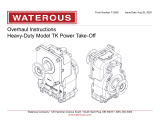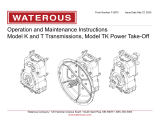Page is loading ...


Table of Contents
Safety 4
Safety Precautions 4
Introduction 5
Using this Document 5
Viewing the Document Electronically 5
Printing the Document 5
Additional Documentation 5
Symbols 5
Identifying Exterior Components—Top 6
Identifying Exterior Components—Bottom 7
Disassembly 8
Preparing to Disassemble the Pump 8
Tools Required 8
Preparing the Apparatus 8
Best Practices 8
Removing the Pump 8
Disassembling the Pump Components 8
Optional Equipment 8
Separating the Pump and Transmission 9
Removing the Packing Cooler Hose 9
Removing the Bearing Housing 10
Removing the Packing Housing Screws 11
Removing the Pump Body Hardware 12
Removing the Dowel Pins 14
Removing the Upper Pump Body and Bearing Cover 15
Removing the Lower Pump Body 16
Removing the Impeller Shaft Assembly 17
Removing the Impeller Shaft Components 18
Assembly 21
Preparing to Assemble the Pump 21
Tools Required 21
Best Practices 21
Optional Equipment 21
Assembling the Pump Components 21
Installing the Pump 21
Understanding the Illustrations 21
Impeller Shaft Assembly 22
Assembling the Bearing Housing 23
Assembling the Impeller Shaft 24
Installing and Tightening the Packing 27
Pump Body Assembly 28
Installing the Lower Pump Body 30
Installing the Bearing Cover 31
Installing the Upper Pump Body 32
Installing the Pump Body Hardware 34
Installing the Packing Housing Hardware 35
Installing the Flinger Ring and Bearing 36
Installing the Bearing Housing 37
Installing the Packing Cooler Hose 38
Testing After Installation 39

4 | 40
Introduction Disassembly Assembly
Safety Precautions
• Read and understand this document before you begin the overhaul.
• Read and understand all the notices and safety precautions.
• Be aware that these instructions are only guidelines and are not meant to be
definitive. Contact Waterous when you have questions.
• Do not overhaul this equipment if you are not familiar with the tools and skills
needed to safely perform the required procedures.
• Do not modify the equipment.
• Waterous reserves the right to make modifications to the instructions without
notice.
Always support heavy
equipment while servicing.
Unsupported equipment
may shift or fall during dis-
assembly, causing injury
or damage.
Unsupported Equipment
•
•
Do not touch the surface
during operation––allow
it to cool after operating.
Hot surface can burn you.
Hot Surface
•
•
Drain the pump after use
and before servicing.
Liquid ejected at high
pressure can cause
serious injury.
High Pressure
•
•

5 | 40
Safety Introduction Disassembly Assembly
Use this document to overhaul your Waterous equipment. Please understand
the following conditions:
• Be aware that these instructions are only guidelines and are not meant to be
definitive. Contact Waterous when you have questions.
• Understand that your configuration may require additional steps, that are not
described in the illustrations or instructions, to perform the overhaul.
• The equipment described in this document is intended to be overhauled by
a person or persons with the necessary skills and knowledge to perform the
overhaul.
This document is divided into the following sections:
Safety
This section describes general precautions and alert symbols that are in this
document.
Introduction
This section is an overview of the document.
Disassembly
This section describes disassembly procedures.
Assembly
This section describes assembly procedures.
Using this Document
Use the guidelines below when viewing this document.
Viewing the Document Electronically
• View this document in landscape orientation.
• Use the table of contents to navigate directly to that section.
• Text with this appearance is linked to a reference.
Printing the Document
• The document is viewed the best when printed in color.
• The print on both sides and flip on long edge features can provide the
best results.
• Use a 3-ring binder to store the document.
Additional Documentation
Additional documentation is available through the MyWaterous login at
Waterousco.com. Use your serial number to gain access to the service parts
list associated with your system. Dimensional drawings are available through
the Waterous Service department.
Symbols
Symbols are used to illustrate additional tools or operations that are required to
complete the instruction.
Arbor press—This symbol tells you to use an arbor press to
complete this step.
Discard—This symbol tells you to discard or recycle the part in
accordance with local regulations.
Finger tight, then full turn—This symbol tells you to secure
the hardware to finger tight, then use a wrench to tighten the
hardware an additional turn.
High-pressure grease—This symbol tells you to apply high-
pressure grease to the surfaces that you are pressing together.
Lubrication—This symbol tells you to apply the appropriate
lubricant to the part.
Sealant—This symbol tells you to apply a appropriate sealant to
the part.
Torque to specification—This symbol tells you to torque the
hardware to the specified value.

8 | 40
Safety Introduction Disassembly Assembly
Preparing to Disassemble the Pump
• Read and understand the instructions before disassembling the equipment.
• Prepare a workspace suitable to accommodate and support the pump.
• Gather the necessary tools, cleaning cloths, brushes, and penetrating fluids.
• Understand that your configuration may require additional steps that are not
described in the illustrations or instructions to perform the disassembly.
• This equipment is intended to be disassembled by a person or persons with
the basic knowledge of servicing similar equipment. Contact Waterous for
more information.
Tools Required
• Typical automotive mechanics hand tools.
• Suitable arbor press.
• Suitable support and lifting equipment.
Preparing the Apparatus
• Park the apparatus on a level surface in a well-lit area.
• Engage the parking brake.
• Shut off the engine and remove the key from the ignition switch.
• Allow the apparatus to cool before servicing.
Best Practices
• Remove any dirt, sand, grease, or oil from the enclosure before you
disassemble the transmission. Surface debris can transfer into the pump
interior and prematurely wear internal parts.
• Only use a clean lint-free cloth, a debris-free work surface, and properly
maintained tools to perform the disassembly.
• Replace any gaskets and O-ring seals during the overhaul.
• Do not reuse the self-locking nuts.
• Apply penetrating oil to screws and nuts before disassembly.
Removing the Pump
Removing the pump for overhaul varies by application. Your application
may require components such as drain lines, support brackets, plumbing
connections, and other accessories be removed or disconnected before
removing the pump.
Furthermore, some applications require you to remove the transmission and
pump together before separating the pump from the transmission. Other
applications allow you to separate the pump without removing the transmission
from the apparatus. Refer to the transmission instructions before proceeding.
Record the process used to remove the equipment from the apparatus. Use
this information to install the equipment into the apparatus after the overhaul.
Disassembling the Pump Components
• Refer to the service parts list (SPL) for part identification and disassemble
order.
Note: Documents specic to your application are available through the
MyWaterous login at Waterousco.com by entering the serial number for
your system. Depending on the application, the serial number for your
equipment is located on the operator panel, pump, transmission, or
some combination of the three.
• Use established industry practices to disassemble the pump.
• Record or mark components as you remove them to make sure that you
install them in the same orientation.
• Discard or recycle drained fluids collected during the overhaul in accordance
with local regulations.
Optional Equipment
Be aware that the disassembly instructions may include optional equipment not
included in your application.

10 | 40
Safety Introduction Disassembly Assembly
Separating the Pump and Transmission
1
2
Removing the Bearing Housing
Use the illustrations and instructions to remove the
bearing housing.
1Remove the bearing housing hardware.
2Remove the bearing housing and bearing from
the pump.
Note: In some cases, the bearing housing
and bearing may need to be removed
separately.

13 | 40
Safety Introduction Disassembly Assembly
Separating the Pump and Transmission
2
1
Removing the Transmission Hardware
Use the illustration and instructions to remove the
upper transmission mounting hardware.
1 Remove the upper transmission mounting
hardware.
2 Loosen, but do not remove, the lower
transmission mounting hardware.

15 | 40
Safety Introduction Disassembly Assembly
Separating the Pump and Transmission
2
1
3
Removing the Upper Pump Body and
Bearing Cover
Use the illustrations and instructions to remove the
upper pump body, gasket, and bearing cover.
1 Remove the upper pump body.
Note: If needed, there are jacking screw
holes to aid in separating the pump
bodies.
2 Remove and discard the gasket material.
3Remove the mounting hardware, bearing
cover, and O-ring, then discard the O-ring.

16 | 40
Safety Introduction Disassembly Assembly
Separating the Pump and Transmission
3
Removing the Lower Pump Body
Use the illustrations and instructions to remove the
remaining transmission mounting hardware and
lower pump body.
1 Remove the nuts and washers.
2 Remove the threaded studs.
3 Remove the lower pump body.
1
2

17 | 40
Safety Introduction Disassembly Assembly
Separating the Impeller Shaft Components
Removing the Impeller Shaft Assembly
Use the illustrations and instructions to remove the
impeller shaft assembly.
1 Use locally sourced jacking screws (3/8-24
UNF with a minimum length of 1-1/2 inches)
to separate the impeller shaft assembly and
transmission case.
2 Remove the impeller shaft assembly from the
transmission case.
1
2

18 | 40
Safety Introduction Disassembly Assembly
Removing the Impeller Shaft Components
14
2 5
3 6
Use the illustrations and instructions to disassemble
the impeller shaft.
1Remove the hardware and gland halves.
2Remove the packing rings and packing
housing. Discard the gasket.
3 Remove the retaining ring.
4 Use an arbor press to remove the wear
rings and impellers up to the interstage seal.
Remove the key after removing the second
impeller.
Note: Make sure to note the orientation of
the impellers as you remove them for
later in the assembly.
5Remove the interstage seal.
6 Remove the retaining ring.

19 | 40
Safety Introduction Disassembly Assembly
Removing the Impeller Shaft Components
7
8
10
9
11
Use the illustrations and instructions to disassemble
the impeller shaft.
7 Use an arbor press to remove the wear rings
and impellers up to the packing housing.
Remove the key after removing the second
impeller.
8 Discard the gasket, then remove the packing
housing, packing rings, gland halves, and
hardware.
9Remove the flinger ring.
10 Remove the hardware, bearing, driven gear,
bearing spacer, and key.
11 Remove the bearing housing.

Notes
/

















